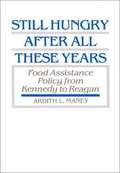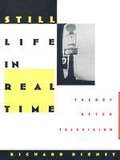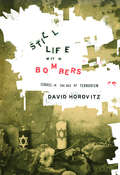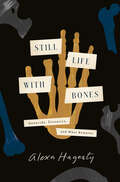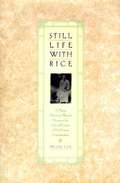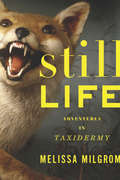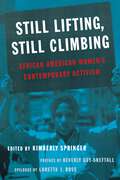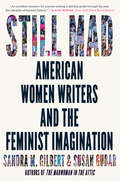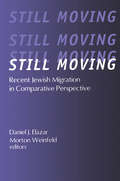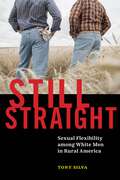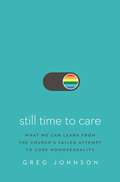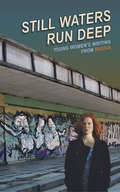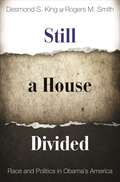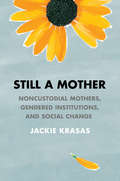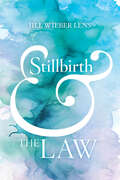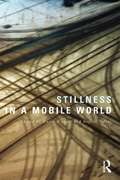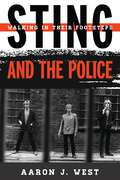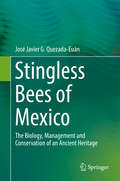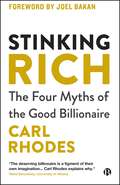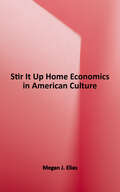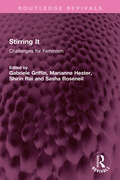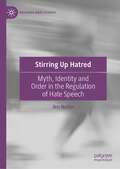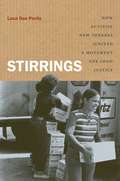- Table View
- List View
Still Hungry After All These Years: Food Assistance Policy from Kennedy to Reagan
by Ardith L. ManeyIn the 1980s, record numbers of Americans have qualified for food stamps and food aid in other forms, despite increasingly rigid standards of eligibility. After more than two decades of such assistance, hunger and malnutrition remain widespread among low-income groups in the United States. This new study examines the policy processes that have shaped food assistance programs since the Kennedy administration and looks at prospects for resolving the political stalemate over food aid that has overtaken national policy. Following an analysis of the dynamics of the policy process, Professor Maney explores the various changes that have affected assistance policy since its first phase beginning in 1933. She describes the shifting course of aid policy, which first aimed at supporting farm income and disposing of agricultural surpluses and more recently has attempted to deal primarily with hunger and severe malnutrition. Focusing on conflicts over policy objectives and budget, the author traces the ups and downs of the struggle between the executive branch and Congress to control both policy and appropriations. Other topics considered are the role of Department of Agriculture planners and administrators, the influence of powerful agricultural interests, the efforts of antipoverty and civil rights activists to secure more equitable food distribution in the rural South, and the effects of joblessness on food assistance policy. A clear and balanced analysis of one of the gravest policy dilemmas facing the nation, this book is an important resource for professionals, politicians, academics, and students concerned with public policy, social issues, government, and contemporary political economy.
Still Life in Real Time: Theory After Television
by Richard DienstTelevision can be imagined in a number of ways: as a profuse flow of images, as a machine that produces new social relationships, as the last lingering gasp of Western metaphysical thinking, as a stuttering relay system of almost anonymous messages, as a fantastic construction of time. Richard Dienst engages each of these possibilities as he explores the challenge television has posed for contemporary theories of culture, technology, and media.Five theoretical projects provide Still Life in Real Time with its framework: the cultural studies tradition of Raymond Williams; Marxist political economy; Heideggerian existentialism; Derridean deconstruction; and a Deleuzian anatomy of images. Drawing lessons from television programs like Twin Peaks and Crime Story, television events like the Gulf War, and television personalities like Madonna, Dienst produces a remarkable range of insights on the character of the medium and on the theories that have been affected by it.From the earliest theorists who viewed television as a new metaphor for a global whole, a liberal technology empty of ideological or any other content, through those who saw it as a tool for consumption, making time a commodity, to those who sense television's threat to being and its intimate relation to power, Dienst exposes the rich pattern of television's influence on philosophy, and hence on the deepest levels of contemporary experience.A book of theory, Still Life in Real Time will compel the attention of all those with an interest in the nature of the ever present, ever shifting medium and its role in the thinking that marks our time.
Still Life with Bombers
by David HorovitzWhen peace talks between Palestinian and Israeli leaders collapsed at Camp David in 2000, a conflict as bloody as any that had ever occurred between the two peoples began. Now David Horovitz—editor of The Jerusalem Report—explores the quotidian and profound effects this conflict and its attendant terrorism have had on the lives of ordinary men, women and children. Horovitz describes the “grim lottery” of life in Israel since 2000. He makes clear that far from becoming blasé or desensitized, its citizens respond with deepening horror every time the front pages are disfigured by the rows of passport portraits presenting the faces of the newly dead. He takes us to the funeral of a murdered Israeli, where the presence of security personnel underlines that nowhere is safe. He describes how his wife must tell their children to close their eyes when they pass a just-exploded bus on the way to school, so that the images of carnage won’t haunt them. He talks with government officials on both sides of the conflict, with relatives of murdered victims, with Palestinian refugees, and with his own friends and family, letting us sense what it feels like to live with the constant threat and the horrific frequency of shootings and suicide bombings. Examining the motives behind the violence, he blames mistaken policies and actions on the Israeli as well as the Palestinian side, and details the suffering of Palestinians deprived of basic freedoms under strict Israeli controls. But at the root of this conflict, he argues, is terrorism and Yasser Arafat’s deliberate use of it after spurning a genuine opportunity for peace at Camp David, and then misleading his people, and much of the world, about what was on offer there. He describes how the world’s press has too often allowed prejudgment to replace fair-minded reporting. And finally, Horovitz makes us see the vast depth and extent of the mistrust between Israelis and Palestinians and the enormous challenges that underlie new attempts at peacemaking. Human and harrowing—and yet projecting an unexpected optimism—Still Life with Bombers affords us a remarkably balanced and insightful understanding of a seemingly intractable conflict. From the Hardcover edition.
Still Life with Bones: Genocide, Forensics, and What Remains
by Alexa HagertyAn anthropologist working with forensic teams and victims&’ families to investigate crimes against humanity in Latin America explores what science can tell us about the lives of the dead in this haunting account of grief, the power of ritual, and a quest for justice.&“Exhumation can divide brothers and restore fathers, open old wounds and open the possibility of regeneration—of building something new with the &‘pile of broken mirrors&’ that is memory, loss, and mourning.&”Throughout Guatemala&’s thirty-six-year armed conflict, state forces killed more than two hundred thousand people. Argentina&’s military dictatorship disappeared up to thirty thousand people. In the wake of genocidal violence, families of the missing searched for the truth. Young scientists joined their fight against impunity. Gathering evidence in the face of intimidation and death threats, they pioneered the field of forensic exhumation for human rights. In Still Life with Bones, anthropologist Alexa Hagerty learns to see the dead body with a forensic eye. She examines bones for marks of torture and fatal wounds—hands bound by rope, machete cuts—and also for signs of identity: how life shapes us down to the bone. A weaver is recognized from the tiny bones of the toes, molded by kneeling before a loom; a girl is identified alongside her pet dog. In the tenderness of understanding these bones, forensics not only offers proof of mass atrocity but also tells the story of each life lost. Working with forensic teams at mass grave sites and in labs, Hagerty discovers how bones bear witness to crimes against humanity and how exhumation can bring families meaning after unimaginable loss. She also comes to see how cutting-edge science can act as ritual—a way of caring for the dead with symbolic force that can repair societies torn apart by violence.Weaving together powerful stories about investigative breakthroughs, histories of violence and resistance, and her own forensic coming-of-age, Hagerty crafts a moving portrait of the living and the dead.
Still Life with Rice
by Helie Lee"In this radiant memoir of her grandmother's life, Helie Lee probes a history and a culture that are both seductively exotic and strangely familiar. And with wit and verve she claims her own Korean identity, illuminating the intricate experiences of Asian-American women." "Born in 1912 - "the year of the rat" - to aristocratic parents, Hongyong Baek came of age in a unified but socially repressive Korea, where she learned the roles that had been prescribed for her: obedient daughter, demure wife, efficient household manager. Ripped from her home first during the Japanese occupation and again during the bloody civil war that divided her country, Hongyong fought to save her family by drawing from her own talents and values. Over the years she provided for her husband and children by running a successful restaurant, building a profitable opium business, and eventually becoming adept at the healing art of Chiryo. When she was pressured to leave her country, she moved with her family to California, where she reestablished her Chiryo practice." "Writing in her grandmother's voice, Helie Lee depicts the concerns and conflicts that shaped one family's search for home. Evocative and keenly felt, Still Life with Rice interprets issues that touch all of us: the complex nature of family relations, the impact of social upheaval on an individual, and the rapidly changing lives of women in this century."--BOOK JACKET.Title Summary field provided by Blackwell North America, Inc. All Rights Reserved
Still Life: Adventures in Taxidermy
by Melissa MilgromAfter her curiosity is piqued by a safari gone awry, a journalist delves into the curious world of taxidermy and shares her findings.It’s easy to dismiss taxidermy as a kitschy or morbid sideline, the realm of trophy fish and jackalopes or an anachronistic throwback to the dusty diorama. Yet theirs is a world of intrepid hunter-explorers, eccentric naturalists, and gifted museum artisans, all devoted to the paradoxical pursuit of creating the illusion of life.Into this subculture of passionate animal-lovers ventures journalist Melissa Milgrom, whose journey stretches from the anachronistic family workshop of the last chief taxidermist for the American Museum of Natural History to the studio where an English sculptor, granddaughter of a surrealist artist, preserves the animals for Damien Hirst’s most disturbing artworks. She wanders through Mr. Potter’s Museum of Curiosities in the final days of its existence to watch dealers vie for preserved Victorian oddities, and visits the Smithsonian’s offsite lab, where taxidermists transform zoo skins into vivacious beasts. She tags along with a Canadian bear trapper and former Roy Orbison impersonator—the three-time World Taxidermy Champion—as he resurrects an extinct Irish elk using DNA studies and Paleolithic cave art for reference; she even ultimately picks up a scalpel and stuffs her own squirrel. Transformed from a curious onlooker to an empathetic participant, Milgrom takes us deep into the world of taxidermy and reveals its uncanny appeal.“Hilarious but respectful.” —Washington Post“Engrossing.” —New Yorker“[A] delightful debut . . . Milgrom has in Still Life opened up a whole world to readers.” —Chicago Tribune“Milgrom’s lively account will appeal to readers who enjoyed Mary Roach’s quirky science books.” —Library Journal
Still Lifting, Still Climbing: African American Women's Contemporary Activism
by Beverly Guy-Sheftall Kimberly Springer Loretta J. RossStill Lifting, Still Climbing is the first volume of its kind to document African American women's activism in the wake of the civil rights movement. Covering grassroots and national movements alike, contributors explore black women's mobilization around such areas as the black nationalist movements, the Million Man March, black feminism, anti-rape movements, mass incarceration, the U.S. Congress, welfare rights, health care, and labor organizing. Detailing the impact of post-1960s African American women's activism, they provide a much-needed update to the historical narrative. Ideal for course use, the volume includes original essays as well as primary source documents such as first-hand accounts of activism and statements of purpose. Each contributor carefully situates their topic within its historical framework, providing an accessible context for those unfamiliar with black women's history, and demonstrating that African American women's political agency does not emerge from a vacuum, but is part of a complex system of institutions, economics, and personal beliefs. This ambitious volume will be an invaluable resource on the state of contemporary African American women's activism.
Still Lives: Jewish Photography in Nazi Germany (Jewish Culture and Contexts)
by Ofer Ashkenazi Sarah Wobick-Segev Rebekka Grossmann Shira MironHow German Jews used photographs to document their experiences in the face of National SocialismStill Lives is a systematic study of the ways Jews used photographs to document their experiences in the face of National Socialism. In a time of intensifying anti-Jewish rhetoric and policies, German Jews documented their lives and their environment in tens of thousands of photographs. German Jews of considerably diverse backgrounds took and preserved these photographs: professional and amateurs, of different ages, gender, and classes. The book argues that their previously overlooked photographs convey otherwise unuttered views, emotions, and self-perceptions. Based on a database of more than fifteen thousand relevant images, it analyzes photographs within the historical contexts of their production, preservation, and intended viewing, and explores a plethora of Jews’ reactions to the changing landscapes of post-1933 Germany. Here, the authors claim that these reactions complement, complicate, and, sometimes, undermine the contents of contemporaneous written sources.Still Lives develops a new methodology for historians to use while reading and analyzing photographs, and shows how one can highlight an image’s role in a narrative that comments on, and assigns meaning to, the reality it documents. In times of radical uncertainty, numerous German Jews used photography to communicate their intricate, confused, and conflicting expectations, fears, and beliefs. Through careful analysis of these photographs, this book lays the foundations for a new history of the German-Jewish experience during the National Socialist years.
Still Mad: American Women Writers And The Feminist Imagination 1950-2020
by Sandra M. Gilbert Susan GubarA brilliant, sweeping history of the contemporary women’s movement told through the lives and works of the literary women who shaped it. Forty years after their first groundbreaking work of feminist literary theory, The Madwoman in the Attic, award-winning collaborators Sandra M. Gilbert and Susan Gubar map the literary history of feminism’s second wave. From its stirrings in the midcentury—when Sylvia Plath, Betty Friedan, and Joan Didion found their voices and Diane di Prima, Lorraine Hansberry, and Audre Lorde discovered community in rebellion—to a resurgence in the new millennium in the writings of Alison Bechdel, Claudia Rankine, and N. K. Jemisin, Gilbert and Gubar trace the evolution of feminist literature. They offer lucid, compassionate, and piercing readings of major works by these writers and others, including Adrienne Rich, Ursula K. Le Guin, Maxine Hong Kingston, Susan Sontag, Gloria Anzaldúa, and Toni Morrison. Activists and theorists like Nina Simone, Gloria Steinem, Andrea Dworkin, Eve Kosofsky Sedgwick, and Judith Butler also populate these pages as Gilbert and Gubar examine the overlapping terrain of literature and politics in a comprehensive portrait of an expanding movement. As Gilbert and Gubar chart feminist gains—including creative new forms of protests and changing attitudes toward gender and sexuality—they show how the legacies of second wave feminists, and the misogynistic culture they fought, extend to the present. In doing so, they celebrate the diversity and urgency of women who have turned passionate rage into powerful writing.
Still Moving: Recent Jewish Migration in Comparative Perspective
by Morton WeinfeldThe aftermath of World War II was a period of massive Jewish migration. More than a million Jews came to settle in the new state of Israel; hundreds of thousands moved to North America, Australia, and France, while tens of thousands resettled themselves elsewhere in Europe and the world. Emigration was, in turn, paralled by large-scale movement among second-generation Jews from the great urban centers to the suburbs. Until recently it has seemed as though the Jewish people had, in the words of the Bible, reached a situation of rest and landed inheritance. However, there is considerable evidence that Jews are still moving: from the former Soviet Union, to and from Israel, and within nations where they have been long resident. Still Moving examines the causes and character of contemporary migration in Israel and throughout the Diaspora.The contributors to this volume adopt a cross-cultural comparative approach. Part 1 establishes the context of the new migration globally with specific concentration on its effects on the institutions of Israeli democracy. Part 2 surveys immigration to Israel in the 1990s with particular emphasis on the wave of Russian emigres since the fall of the Soviet Union. Internal migration from rural to urban centers is also explored. Migration to the Diaspora is covered in part 3. The Jewish identity of Soviet Jews is compared to their American and Canadian counterparts. Economic performance and problems of multigenerational families among emigres are also treated, as are the controversies surrounding politically motivated emigration from Israel. Part 4 focuses on the changing nature of the Diaspora and its relations with Israel. Beyond its grounding in Jewish culture and history, Still Moving frames questions that are central to understanding contemporary migration in general: Does immigration accelerate or retard the abilities of host countries to restructure economically? How does greater ethnic diversity affect the social and cultural life of cities? What factors help immigrants integrate into the wider community? Does immigration contribute to the creation of a marginalized underclass? Still Moving will be essential reading for historians, sociologists, Jewish studies specialists, and policy analysts.
Still Straight: Sexual Flexibility among White Men in Rural America
by Tony SilvaWhy some straight men have sex with other menWhy do some straight men in rural America have sex with other men? In Still Straight, Tony Silva convincingly argues that these men—many of whom enjoy hunting, fishing, and shooting guns—are not gay, bisexual, or “just experimenting.” As he shows, these men can enjoy a range of relationships with other men, from hookups to sexual friendships to secretive loving partnerships, all while strongly identifying with straight culture.Drawing on riveting interviews with straight white men who live in rural America, Silva explores the fascinating, and unexpected, disconnect between sexual behavior and identity. Some use sex with men to bond with other men in an acceptably masculine way; some are not particularly attracted to men, but are wary of emotional attachment with women; and others view sex with men—as opposed to women—as a more acceptable form of extramarital sexual behavior.Taking us inside the lives of straight white men who have sex with other men, Still Straight shows us that heterosexuality in rural America is not always, in fact, what it seems.
Still Time to Care: What We Can Learn from the Church’s Failed Attempt to Cure Homosexuality
by Greg JohnsonCharting the path forward for our churches and ministries in providing care—not a cure— for our non-straight sisters and brothers who are living lives of costly obedience to Jesus.At the start of the gay rights movement in 1969, evangelicalism's leading voices cast a vision for gay people who turn to Jesus. It was C.S. Lewis, Billy Graham, Francis Schaeffer and John Stott who were among the most respected leaders within theologically orthodox Protestantism. We see with them a positive pastoral approach toward gay people, an approach that viewed homosexuality as a fallen condition experienced by some Christians who needed care more than cure.With the birth and rise of the ex-gay movement, the focus shifted from care to cure. As a result, there are an estimated 700,000 people alive today who underwent conversion therapy in the United States alone. Many of these patients were treated by faith-based, testimony-driven parachurch ministries centered on the ex-gay script. Despite the best of intentions, the movement ended with very troubling results. Yet the ex-gay movement died not because it had the wrong sex ethic. It died because it was founded on a practice that diminished the beauty of the gospel.Yet even after the closure of the ex-gay umbrella organization Exodus International in 2013, the ex-gay script continues to walk about as the undead among us, pressuring people like me to say, "I used to be gay, but I'm not gay anymore. Now I'm just same-sex attracted."For orthodox Christians, the way forward is to take a close look at our history. It is time again to focus with our Neo-Evangelical fathers on caring over attempting to cure.With warmth and humor, as well as original research, Still Time to Care provides:Guidance for the gay person who hears the gospel and finds themselves smitten by the life-giving call of Jesus.Guidance for the church to repent of its homophobia and instead offer gospel-motivated love and compassion.
Still Waters Run Deep
by Yaroslava Pulinovich Irina Bogatyreva Olga Rimsha Anna Lavrinenko Ksenia ZhukovaThese frank, unsparing, and varied stories by women in their twenties and thirties reveal the evolution of women's consciousness in Russia through two decades of violent social upheaval-including the dramatic monologue of a teenage girl who grew up in an orphanage; an escape to the Altai Mountains and the mysterious local rites and lore; the seamy side of Siberian business and a young man's failure to get to grips with it; the tricky backstage life of a provincial theater; the private life of a wealthy family which mirrors the social stratification in Russian society today.
Still a House Divided: Race and Politics in Obama's America (Princeton Studies in American Politics: Historical, International, and Comparative Perspectives #125)
by Rogers M. Smith Desmond KingWhy race remains the central political issue in America todayWhy have American policies failed to reduce the racial inequalities still pervasive throughout the nation? Has President Barack Obama defined new political approaches to race that might spur unity and progress? Still a House Divided examines the enduring divisions of American racial politics and how these conflicts have been shaped by distinct political alliances and their competing race policies. Combining deep historical knowledge with a detailed exploration of such issues as housing, employment, criminal justice, multiracial census categories, immigration, voting in majority-minority districts, and school vouchers, Desmond King and Rogers Smith assess the significance of President Obama's election to the White House and the prospects for achieving constructive racial policies for America's future.Offering a fresh perspective on the networks of governing institutions, political groups, and political actors that influence the structure of American racial politics, King and Smith identify three distinct periods of opposing racial policy coalitions in American history. The authors investigate how today's alliances pit color-blind and race-conscious approaches against one another, contributing to political polarization and distorted policymaking. Contending that President Obama has so far inadequately confronted partisan divisions over race, the authors call for all sides to recognize the need for a balance of policy measures if America is to ever cease being a nation divided.Presenting a powerful account of American political alliances and their contending racial agendas, Still a House Divided sheds light on a policy path vital to the country's future.
Still a Man's World: Men Who Do Women's Work (Men and Masculinity #1)
by Christine L. WilliamsMen who do "women's work" have consistently been the butt of jokes, derided for their lack of drive and masculinity. In this eye-opening study, Christine Williams provides a wholly new look at men who work in predominantly female jobs. Having conducted extensive interviews in four cities, Williams uncovers how men in four occupations—nursing, elementary school teaching, librarianship, and social work—think about themselves and experience their work.Contrary to popular imagery, men in traditionally female occupations do not define themselves differently from men in more traditional occupations. Williams finds that most embrace conventional, masculine values. Her findings about how these men fare in their jobs are also counterintuitive. Rather than being surpassed by the larger number of women around them, these men experience the "glass escalator effect," rising in disproportionate numbers to administrative jobs at the top of their professions. Williams finds that a complex interplay between gendered expectations embedded in organizations, and the socially determined ideas workers bring to their jobs, contribute to mens' advantages in these occupations.Using a feminist psychoanalytic perspective, Williams calls for more men not only to cross over to women's occupations, but also to develop alternative masculinities that find common ground with traditionally female norms of cooperation and caring. Until the workplace is sexually integrated and masculine and feminine norms equally valued, it will unfortunately remain "still a man's world."
Still a Mother: Noncustodial Mothers, Gendered Institutions, and Social Change
by Jackie KrasasJackie Krasas traces the trajectories of mothers who have lost or ceded custody to an ex-partner. She argues that these noncustodial mothers' experiences should be understood within a greater web of gendered social institutions such as employment, education, health care, and legal systems that shapes the meanings of contemporary motherhood in the United States. If motherhood means "being there," then noncustodial mothers, through their absence, are seen as nonmothers. They are anti-mothers to be reviled. At the very least, these mothers serve as cautionary tales.Still a Mother questions the existence of an objective method for determining custody of children and challenges the "best-interests standard" through a feminist, reproductive justice lens. The stories of noncustodial mothers that Krasas relates shed light on marriage and divorce, caregiving, gender violence, and family court. Unfortunately, much of the contemporary discussion of child custody determination is dominated either by gender-neutral discussions, or, at the opposite end of the spectrum, by the idea that fathers are severely disadvantaged in custody disputes. As a result, the idea that mothers always receive custody has taken on the status of common sense. If this was true, as Krasas affirms, there would be no book to write.
Stillbirth and the Law
by Jill Wieber LensEach year in the United States, about 1 in 170 births is a stillbirth, a rate that has remained stagnant for most of this century even as other high-income countries have dramatically reduced their already lower rates. Jill Wieber Lens, the nation’s foremost expert on stillbirth and the law, blends personal experience and legal analysis to bring us an original, essential guide to this all-too-often unrecognized public health crisis. By exposing how the law inhibits prevention, affects the experience of stillbirth for birthing parents, and shapes broader notions of unborn life, Lens argues for a series of pragmatic, data-driven changes to the legal landscape that could enjoy broad popular support and strengthen reproductive justice and reproductive rights.
Stillness in a Mobile World (International Library of Sociology)
by David Bissell Gillian FullerThis edited collection of essays on the conceptual, political and philosophical importance of stillness is positioned within a world that has increasingly come to be understood through the theoretical and conceptual lens of movement. With contributions from leading scholars in the field, the diversity of this collection illuminates the multiplicity of ontological and epistemological registers through which stillness moves: from human geography to media studies, cultural theory to fine arts. With the help of luminaries such as Deleuze, Bergson, Barthes and Beckett, this book interweaves cutting-edge theoretical insight with empirical illustrations which examine and traverse a multitude of practices, spaces and events. In an era where stasis, slowness and passivity are often held to be detrimental, this collection puts forward a new set of political and ethical concerns which help us to come to terms with, understand, and account for (im)mobile life. Stillness in a Mobile World in an essential source of reference for both undergraduate and post-graduate students working within disciplines such as cultural studies, sociology, mobility studies, and human geography.
Sting and The Police: Walking in Their Footsteps (Tempo: A Rowman & Littlefield Music Series on Rock, Pop, and Culture)
by Aaron J West&“An excellent look at how the Police accomplished success . . . West is especially good at examining how the band used the nascent MTV to define themselves.&” ―Publishers Weekly During the 1980s, The Police were one of the biggest bands in the world. Yet after only five albums—and at the peak of their popularity—they disbanded, and Sting began a solo career that made him a global pop star. Today, artists from Puff Daddy to Gwen Stefani credit The Police and Sting as major influences on their own work. In this book, Aaron J. West explores the cultural and musical impact of Stewart Copeland, Andy Summers, and Sting. West details the distinctive hybrid character of The Police&’s musical output, which would also characterize Sting&’s post-Police career. Sting&’s long-lived solo career embodies the power of the artful appropriation of musical styles, while capitalizing on the modern realities of pop music consumption. The Police—and Sting in particular—were pioneers in music video, modern label marketing, global activism, and the internationalization of pop music. Sting and The Police: Walking in Their Footsteps is a feast for fans—and by placing the band within its various musical, cultural, commercial, and historic contexts, it&’s also fascinating reading for anyone interested in global popular music culture.
Stingless Bees of Mexico
by José Javier Quezada-EuánThe stingless bees are the most diverse group of highly social bees and are key species in our planet’s tropical and subtropical regions, where they thrive. In Mexico, the management of stingless bees dates back centuries, and they were an essential part of the culture and cosmogony of native peoples like the Maya. In recent decades a vast amount of information has been gathered on stingless bees worldwide. This book summarizes various aspects of the biology and management of stingless bees, with special emphasis on the Mexican species and the traditions behind their cultivation. Much of the information presented here was produced by the author and the team of researchers at the Universidad Autónoma de Yucatán in the course of three decades of working with these insects. Given the breadth of its coverage, the book offers an equally valuable reference guide for academics, students and beekeepers alike.
Stinking Rich: The Four Myths of the Good Billionaire
by Carl RhodesBillionaires are an ultra-elite social class whose numbers are growing alongside their obscene wealth while others struggle, suffer or even die. They represent a scourge of economic inequality, but how do they get away with it? A set of dangerous and deceptive inter-connected myths portrays them as a ‘force for good’: - the ‘heroic billionaire’ asserts they are gallant protagonists of the American Dream gone global - the ‘generous billionaire’ pretends that their philanthropic efforts and personal good deeds should be lauded for generosity and benevolence - the ‘meritorious billionaire’ insists that extreme wealth is a worthy reward for individual hard work and talent - the ‘vigilante billionaire’ claims to be able to solve the world’s biggest problems where bureaucrats and politicians have failed. Each of these myths enables billionaire wealth and power to set us back to old-style feudalism and plutocracy. Offering a trenchant critique, this incisive book testifies to the growing international political will to take concrete actions in supporting economic justice and democratic equality.
Stir It Up: Home Economics in American Culture
by Megan J. EliasFor Americans who came of age in the mid-twentieth century, home economics conjures memories of burnt toast and sewing disasters. But as historian Megan Elias shows in Stir It Up, home economics began as an idealistic reform movement in higher education in the early 1900s. Leaders of this movement sought to discover and disseminate the best methods for performing domestic work while creating new professional options for women that were based on elements of home life. Home and family were treated as subjects for scientific analysis; students wore lab coats while baking bread and performed rigorous tests on the palatability of their work. The Federal Bureau of Home Economics supplied a grateful audience with informational bulletins as Americans seemed to accept the idea that home could be a site for social change. <p><p>A major shift occurred in the 1950s, when new ideas about women's roles seemed to divert home economics into more traditional channels, and "home ec" became identified with the era's conformist culture. Even as home economists were redefining family dynamics and influencing government policies, such as school lunch programs, their field was becoming an object of scorn, especially to the feminists of the 1960s. Stir It Up explains what the successes and failures of home economists can tell us about American culture. The book concludes with an examination of contemporary attitudes toward domesticity, putting the phenomena of Martha Stewart, Rachael Ray, Ty Pennington, and the "Mommy Wars" into historical context.
Stirring It: Challenges for Feminism (Routledge Revivals)
by Gabriele Griffin Marianne Hester Sasha Roseneil Shirin RaiFirst published in 1994 Stirring It debates the challenges which confront feminism and Women's Studies in the 1990s. In the face of current worldwide political and social upheavals, Stirring It poses questions about women, their bodies, their identities, and positions which need to be addressed by contemporary feminists. The chapters therefore challenge the orthodoxies and theories which are exploded by contemporary feminist practice. They raise new issues for feminist debate. The volume is divided into four sections: ‘Feminist Politics in Action’ investigates the inter-relationship between politics and action with reference to issues such as the women's movement in Britain and women's position in and in relation to Ireland; ‘Disrupting Sexual Identities’ provides critiques of heterosexuality, monogamy, and conceptualization of the female body; ‘Imaging and Imagining’ explores the politics of women's cultural production and ‘Women's Studies and Feminist Practice’ analyzes the often fraught connections between theory and practice. This is a must read for scholars and researchers of Women's Studies, Sociology, and Gender Studies.
Stirring Up Hatred: Myth, Identity and Order in the Regulation of Hate Speech (Palgrave Hate Studies)
by Jen NellerThis book critically examines the development of the ‘stirring up hatred’ offences which are currently found within the UK’s Public Order Act 1986. Through a critical discourse analysis of key excerpts of parliamentary Hansard, the book constructs a detailed genealogy of the offences from the perspectives that shaped them. A novel application of theory on 'myth' is used to navigate the complex arguments and to trace ideas about identity and order across parliamentary debates, from fears of Fascism in the 1930s to condemnations of homophobia in the early 21st century. The story of the stirring up hatred offences told in this book therefore extends far beyond the traditional frame of a dilemma between regulating hate speech and safeguarding free speech: it is inextricably entwined with myths about law, race and national identity, and speaks to wider themes of coloniality, neoliberalism, white entitlement, British-Christian exceptionalism and the innocence of law. Written in an accessible and engaging style, this book challenges a wide range of assumptions about hate speech law and raises a series of considerations for developing forms of accountability that are less complicit in the harms that they are supposed to redress.
Stirrings
by Lana Dee PovitzStirrings: How Activist New Yorkers Ignited a Movement for Food Justice
